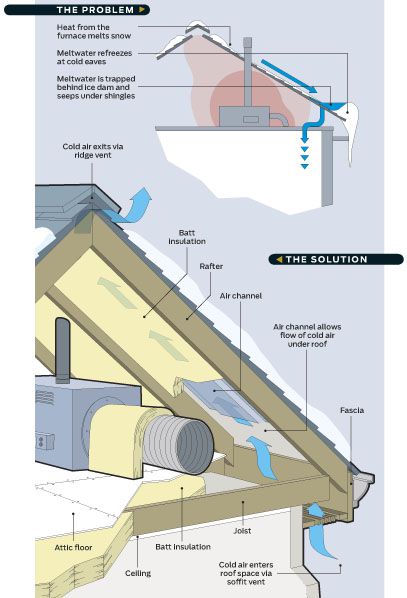How to Prevent Ice Dams, and What to Do If You Get Them
The cold season brings snow-packed roofs across the country and with snow melt can come damaging ice dams. Without a properly insulated attics, however, homeowners could find themselves with an ice dam upstairs. Heat from the attic melts snow on the roofs, and the melted water pools and gets in the house. Here is how to avoid these frosty formations, and what you should do if they do appear on your roof.
 To prevent an ice dam, don't heat the roof, keep it cold. That way, the snow on the roof eventually dissipates without making large amounts of meltwater. The underside of the roof deck should not exceed 30 F.
To prevent an ice dam, don't heat the roof, keep it cold. That way, the snow on the roof eventually dissipates without making large amounts of meltwater. The underside of the roof deck should not exceed 30 F.
The best way to maintain low temperatures is by ensuring that there is adequate insulation and sealing gaps that let warm air pass into the attic from the house. The attic must also be ventilated, so that cold air is introduced into it and heated air escapes rapidly. Some remodeling contractors are under the impression that heat passing through the attic helps prevent ice dams, when just the opposite is true. Although excess heat moving from the attic through the roof rapidly melts snow, once the meltwater touches the cold eaves, it quickly freezes and forms an ice dam.
If you have a furnace in the attic, it may not be possible to prevent ice dams. Increased insulation, however, should help. First, insulate the areas between the roof rafters. It is important to keep an air space between the roof deck and the insulation in order to prevent a condensation buildup that can delaminate the roof deck. Prior to insulating, install polystyrene rafter air channels, which are available at home centers. Next, lay unfaced insulation batts or blankets over the furnace's heating ducts to help reduce the heat buildup in the attic. If there's a hatchway into the attic, build a cover for it out of rigid poly-styrene insulation.
If the gable and ridge vents do not generate sufficient air movement to dissipate the heat, you will need a motorized vent at one end of the attic to exhaust the heat, and an adequately sized vent on the opposite end of the attic to draw in cold air from the outside.
Click Here to continue reading the rest of the article at PopularMechanics.com. (PopularMechanics.com, PM Editors, Nov, 23,2008)